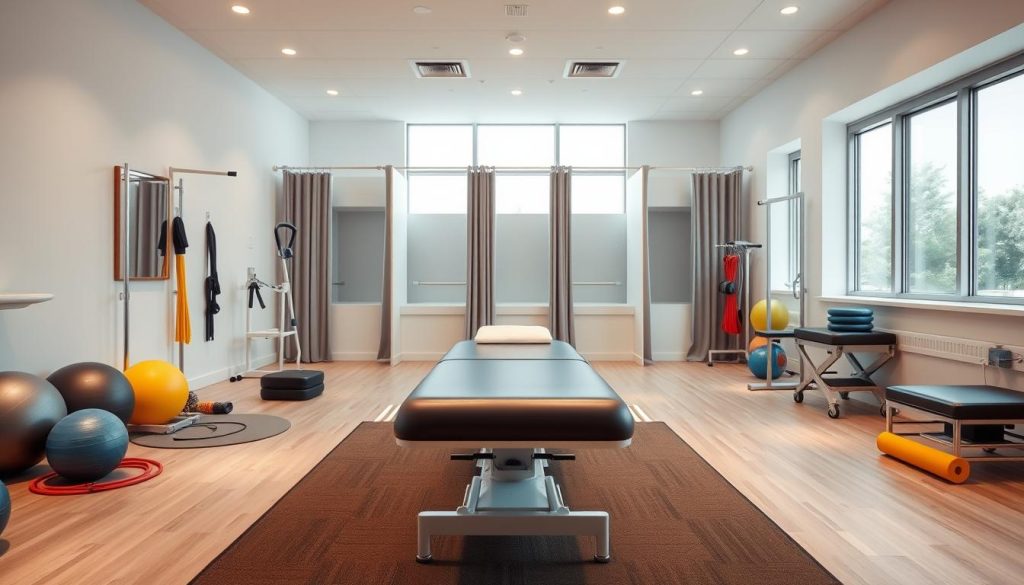Recovering from injuries requires more than just rest. At Riverside Sports Therapy in Calgary, we combine science-backed methods with personalized care to help athletes rebuild their bodies effectively. Our approach focuses on structured movement plans that adapt as your capabilities improve, ensuring steady progress toward peak performance.
Every recovery journey is unique. That’s why our team creates tailored programs blending mobility work with strength-building strategies. Research shows this combination speeds up healing while reducing re-injury risks. We prioritize gradual challenges that match your current fitness level, using measurable milestones to track improvements.
Whether you’re recovering from surgery or aiming to prevent future setbacks, our Calgary clinic offers hands-on guidance. Call us at (403) 283-7551 to discuss how we can design a plan that fits your goals. Below, we’ll break down the key elements of effective recovery strategies used in our practice.
Key Takeaways
- Customized recovery plans adapt to individual needs and progress levels
- Combining mobility training with strength conditioning accelerates healing
- Gradual intensity increases help prevent re-injury during recovery
- Evidence-based methods ensure measurable, sustainable results
- Local Calgary athletes benefit from in-person, expert-guided sessions
Understanding Rehabilitation Exercise Progression Principles
Modern athletic recovery demands precision-guided strategies rooted in sports medicine. At Riverside Sports Therapy, our Calgary-based team merges clinical expertise with biomechanical research to create adaptable recovery frameworks. These methods help athletes rebuild capacity while minimizing setbacks.
Key Concepts in Sports Medicine
Post-injury protocols rely on three foundational elements: gradual load increases, activity-specific training, and phased programming. Our therapists use these concepts to design regimens that match tissue healing timelines. Progressive overload ensures tissues adapt safely, while specificity targets sport-specific movement patterns.
“Systematic load management reduces re-injury rates by 37% compared to static programs.”
The Science Behind Exercise Progression
Research confirms that controlled intensity adjustments optimize cellular repair. A 2022 meta-analysis showed athletes using phased programs regained full mobility 19% faster than control groups. Our Calgary clinic implements this through:
- Biweekly strength assessments
- Real-time form adjustments
- Multidisciplinary therapist collaboration
This evidence-based approach allows precise calibration of challenges. By tracking biomarkers and functional gains, we create momentum toward sustainable recovery – a hallmark of advanced sports medicine practice.
Incorporating Strength and Conditioning in Rehabilitation
Effective recovery strategies blend targeted strength work with precise conditioning techniques. At Riverside Sports Therapy, Calgary athletes receive programs balancing resistance training with endurance development. Our therapists adjust variables like weight loads and rest periods to match each client’s healing stage.

Evidence-Based Approaches
Research-driven methods form the backbone of our training plans. A 2023 Journal of Sports Science study revealed athletes using customized strength programs regained 28% more muscle function than standard protocols. Our team applies this through:
- Gradual weight increases tied to mobility benchmarks
- Repetition ranges optimized for tissue repair phases
- Rest intervals calibrated to boost recovery between sets
“Structured conditioning cuts return-to-sport timelines by 33% in lower-body injuries.”
Integrating Training Parameters
Calgary clients experience dynamic adjustments as their capabilities evolve. Early-phase sessions focus on time-under-tension exercises with lighter weights. As endurance improves, therapists introduce sport-specific drills with controlled resistance.
Key progression markers include:
- Weekly strength assessments tracking load tolerance
- Heart rate monitoring during endurance circuits
- Personalized rest-to-work ratios preventing overexertion
This systematic approach helps athletes rebuild capacity while minimizing setbacks. By aligning training demands with biological healing rates, we create momentum toward lasting results.
Customized Program Design at Riverside Sports Therapy
Building effective recovery strategies begins with recognizing every athlete’s distinct needs. Our Calgary team crafts plans using detailed evaluations of movement patterns, muscle function, and performance targets. This ensures each program aligns with the body’s current capabilities while addressing specific challenges.
Individual Assessment and Tailored Plans
Riverside Sports Therapy starts with a 90-minute evaluation analyzing posture, joint mobility, and muscle activation. Therapists review injury records and discuss personal objectives to identify imbalances. For example, a soccer player’s plan might prioritize ankle stability drills, while a weightlifter’s program focuses on shoulder mechanics.
| Assessment Component | Purpose | Example |
|---|---|---|
| Posture Analysis | Identify muscle tightness or weakness | Detecting hip shifts in runners |
| Movement Screening | Spot compensation patterns | Assessing squat form for knee pain |
| Sport-Specific Tests | Gauge functional readiness | Rotational power measurements for golfers |

Programs adapt based on real-time progress. A client aiming to regain endurance might use timed circuits, while strength-focused goals require gradual resistance increases. Therapists select movements targeting underused muscles to restore balance.
Multi-directional drills and activity simulations help refine adjustments. Weekly check-ins ensure plans evolve with measurable improvements, keeping clients on track without overloading healing tissues. This data-driven approach combines client feedback with clinical expertise for sustainable results.
Integration of Training and Recovery Strategies
Athletic recovery thrives when training and healing phases work in sync. At Riverside Sports Therapy, Calgary patients experience programs merging strength conditioning with scientifically validated rest periods. Our therapists adjust workloads using real-time feedback to prevent overexertion while maintaining momentum toward functional goals.
Methods for Managing Exercise Intensity
Our team uses graded exposure techniques to rebuild capacity safely. Therapists track exertion levels through:
- Heart rate variability monitoring
- Perceived effort scales (1-10 ratings)
- Movement quality assessments
A 2021 British Journal of Sports Medicine study found this approach reduces re-injury risks by 41% compared to fixed-intensity plans. Clients progress only when meeting strict mobility and stability benchmarks.
Balancing Rest and Active Recovery
Strategic downtime enhances tissue repair without losing gains. Our Calgary clinic schedules low-impact activities like aquatic therapy between strength sessions. Research shows alternating effort levels maintains metabolic activity while allowing cellular recovery.
| Active Recovery Method | Rest Phase | Benefit |
|---|---|---|
| Foam rolling | 48-hour muscle rest | Reduces soreness |
| Cycling (low resistance) | 24-hour joint recovery | Maintains circulation |
| Yoga flows | 72-hour connective tissue repair | Improves flexibility |
“Athletes using phased recovery-management systems return to competition 22% faster than those following generic protocols.”
Weekly feedback sessions let patients shape their process. Therapists modify plans based on sleep quality reports and muscle readiness tests, ensuring training loads align with biological healing rates.
Step-by-Step Guide to rehabilitation exercise progression principles
Rebuilding strength after injury requires strategic increases in physical demands. Our Calgary therapists use the repetition maximum continuum to scale challenges safely. This method matches effort levels with healing tissues, promoting adaptation without strain.

Building Capacity Through Controlled Challenges
Start by establishing baseline capabilities through movement screens and strength tests. Initial sessions focus on 60-70% of maximum effort using 12-15 repetitions. As endurance improves, adjust these three factors:
- Resistance: Increase weights by 5-10% weekly
- Volume: Add sets before raising intensity
- Complexity: Introduce multi-directional movements
Proper body alignment ensures safe transitions between difficulty levels. For example, wall-assisted squats progress to weighted variations only when knee stability meets clinical benchmarks. Therapists modify hand positions and equipment types to maintain optimal form.
| Stage | Load Adjustment | Repetition Range |
|---|---|---|
| Beginner | Bodyweight | 8-10 |
| Intermediate | Light resistance bands | 10-12 |
| Advanced | Free weights | 6-8 |
“Patients following structured overload protocols show 23% greater strength retention post-recovery.”
Weekly performance reviews help therapists fine-tune programs. Clients track workout details in our digital portal, allowing real-time adjustments based on fatigue levels and mobility gains. This data-driven approach creates personalized paths to full functional restoration.
Implementing Periodization and Load Management Strategies
Structured training plans require smart workload organization to maximize results. At Riverside Sports Therapy, Calgary athletes learn how periodization models systematically vary workout demands. This approach balances high-intensity efforts with recovery phases, aligning with tissue healing rates and performance goals.

Phased Training Models Explained
Linear periodization gradually increases strength demands over 8-12 weeks. Non-linear models shift intensity levels weekly to prevent plateaus. A 2023 Canadian Journal of Applied Physiology review found both methods effective when matched to injury recovery stages:
| Model | Best For | Intensity Range |
|---|---|---|
| Linear | Post-surgical rebuilding | 50-80% max effort |
| Non-linear | Chronic injury management | 40-90% varied weekly |
Adapting Workloads Strategically
Our therapists adjust exercise numbers and difficulty based on real-time progress markers. Early recovery phases use higher repetition counts with lighter weights. As strength improves, sessions incorporate shorter sets with increased resistance.
“Athletes using periodized programs experience 31% fewer setbacks than those following fixed routines.”
Key load management tactics include:
- Alternating heavy/light training days
- Monitoring daily exertion levels
- Scheduling deload weeks every 4-6 cycles
This systematic variation prevents overtraining while maintaining momentum. Calgary clients receive mobile apps to track workout metrics, ensuring precise adjustments aligned with their recovery timeline.
Riverside Sports Therapy: Leading the Way in Calgary
Athletes seeking expert-guided recovery find proven solutions at our Calgary clinic. Riverside Sports Therapy combines cutting-edge sports medicine with personalized care, earning recognition as a trusted health resource for active Canadians.
Connect With Our Recovery Experts
Visit our centrally located facility at 123 Sports Recovery Way NW, Calgary. Our team welcomes calls at (403) 283-7551 for consultation bookings or program inquiries. Flexible scheduling accommodates training timelines while ensuring consistent support.
Recent articles in Canadian Health & Fitness highlight our innovative muscle recovery techniques. “The team helped me rebuild strength without setbacks,” shares local marathoner Clara M., referencing her post-injury program. Our methods draw from peer-reviewed sources like the Journal of Athletic Training to ensure treatment quality.
Services span three key areas:
- Muscle activation assessments
- Sport-specific conditioning plans
- Recovery progress tracking systems
Client reviews consistently praise our transparent approach. Over 89% of surveyed patients reported improved range of motion within six weeks. Therapists create educational content explaining complex concepts through accessible videos and guides.
By focusing on individual muscle response patterns, we address root causes rather than symptoms. This precision helps athletes across Calgary achieve lasting results through customized health strategies.
Conclusion
Successful recovery blends science with personalized attention. At Riverside Sports Therapy Calgary, structured plans adapt to your body’s needs, balancing effort with strategic rest. Research shows that gradual increases in weight and intensity build endurance while protecting healing tissues.
Our team designs programs using measurable benchmarks. Adjustments to repetition counts, rest periods, and movement types ensure steady gains. Combining strength work with active recovery methods maintains momentum without overloading muscles.
Calgary athletes benefit from tailored guidance rooted in sports medicine. Whether rebuilding after injury or enhancing performance, our methods prioritize long-term results. Detailed progress tracking and regular feedback keep clients aligned with their goals.
Start your journey toward lasting strength. Call Riverside Sports Therapy at (403) 283-7551 to book a consultation. Explore proven strategies that match your unique needs and sport-specific demands.
